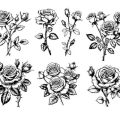Identifying Common UK Lawn Pests and Diseases
If you’ve ever gazed over your garden, only to spot mysterious brown patches or thinning grass, you’re certainly not alone. British lawns face a unique set of challenges, with persistent pests and diseases threatening even the most lovingly tended turf. Among the most notorious culprits are chafer grubs—those sneaky beetle larvae burrowing beneath the surface—and red thread disease, which leaves unsightly reddish-pink threads across your lawn. Recognising these early warning signs is crucial for every gardener hoping to preserve their green oasis.
Keep an eye out for birds pecking repeatedly at the grass, which often signals a chafer grub infestation beneath the surface. Similarly, if you notice patches of grass that look as though they’ve been dusted with fine, pinkish threads, red thread disease may be at work. Timely identification allows you to intervene before these issues escalate. By tuning into the subtle messages your lawn sends—much like listening carefully to what our children tell us—we can nurture healthier gardens and create outdoor spaces where families and nature flourish together.
Assessing Lawn Damage: When to Take Action
Understanding when your lawns troubles warrant intervention is a crucial step in maintaining a healthy, vibrant outdoor space. Not every brown patch or uneven tuft means it’s time to call in the professionals, but some issues—like chafer grubs and red thread disease—can swiftly spiral if left unchecked. Here’s how you can assess the severity of common lawn problems, determine threshold levels for action, and confidently decide whether professional support is needed.
Spotting the Signs: Initial Assessment
Begin with a careful walk-around, noticing changes in colour, texture, and density. Minor issues such as isolated discolouration or sparse patches may respond well to routine care like overseeding or fertilising. However, widespread yellowing, rapid die-back, or visible pests signal more serious trouble.
Threshold Levels for Common Lawn Problems
| Problem | Mild (DIY Care) | Moderate (Consider Help) | Severe (Professional Needed) |
|---|---|---|---|
| Chafer Grubs | Few birds pecking, minor turf lift | Patches easily roll back, several grubs per sq ft | Large bare areas, turf rolls up like a carpet, many grubs visible |
| Red Thread Disease | Sporadic pink/red threads on grass tips | Patches expanding despite regular mowing | Widespread die-off, persistent even after feeding |
| Moss/Weeds | Scattered growth in shaded spots | Increasing coverage each season | Moss/weeds dominant over grass species |
| Compaction/Thatch | Slightly firm ground, water drains slowly | Noticeable pooling after rain, spongy feel underfoot | Lawn feels hard as concrete or extremely spongy; grass thinning out rapidly |
When to Seek Professional Help?
If your inspection reveals persistent symptoms despite your best efforts—or if you’re unsure about the cause—it may be wise to consult a local expert. British lawn care professionals are well-versed in our unique climate challenges and can accurately diagnose complex issues.
Guidance Summary:
- Mild cases: Try home remedies and monitor progress.
- Moderate cases: Seek advice from local garden centres or reputable online resources.
- Severe cases: Contact professional lawn care services for targeted treatment and ongoing management plans.
A timely assessment not only preserves the beauty of your garden but also fosters a sense of stewardship—a lesson we pass down to our children as we nurture both lawns and life together.

3. Expert Approaches to Pest Management
When lawn pests take hold, turning your garden into a patchy battleground, it’s time to consider expert solutions that are both effective and environmentally conscious. In the UK, professional lawn care specialists rely on an impressive toolkit of strategies tailored to our local ecosystem and seasonal rhythms.
Biological Controls: Nature’s Own Team
One standout method is the use of biological controls—introducing natural predators or beneficial organisms to keep pests like chafer grubs in check. For example, nematodes (microscopic worms) are often applied to lawns suffering from chafer grub infestations. These tiny allies seek out and destroy grubs beneath the turf, offering a child-friendly and pet-safe alternative to chemical pesticides. It’s a clever bit of teamwork straight from nature’s playbook, harnessing the balance found in wild meadows.
Targeted Treatments: Precision and Care
For tougher cases or when dealing with surface-dwelling pests like leatherjackets, professionals favour targeted applications of pest-specific treatments. Rather than blanket spraying, UK experts assess each situation individually, applying products only where needed and at the most effective times. This reduces environmental impact while safeguarding pollinators and beneficial insects—a practice in line with our British love for wildlife-friendly gardening.
Integrated Pest Management (IPM): The Holistic Approach
Many UK professionals now adopt Integrated Pest Management (IPM), combining routine monitoring, cultural practices (like aeration and proper mowing), biological interventions, and minimal chemical use as a last resort. This blend ensures long-term health for your lawn—just as a parent encourages good habits in children for lasting well-being.
Why Professional Help Makes a Difference
While DIY approaches can be tempting, persistent infestations often require the precision and knowledge that comes from years of experience. Certified lawn care experts understand the subtle cues—soil type, grass species, timing—that make all the difference between short-term fixes and lasting results. By entrusting your green space to a skilled hand, you’re choosing both reliability and the wisdom of time-tested methods cherished across Britain.
4. Best Practices for Disease Control and Prevention
Effective control and prevention of lawn diseases, particularly fungal issues like red thread, require a thoughtful approach tailored to the unique demands of British gardens. Understanding the local climate, typical grass species, and seasonal challenges is key to achieving a resilient, healthy lawn.
Understanding Red Thread and Fungal Threats
Red thread (Laetisaria fuciformis) thrives in cool, damp British conditions, often appearing as pinkish-red strands amidst fading grass. Fungal diseases weaken your turf’s vigour and appearance, especially during wet summers or mild winters common across the UK.
British Lawn Care Routines for Prevention
| Lawn Care Practice | How It Helps | UK-Specific Tip |
|---|---|---|
| Regular Mowing | Prevents excessive moisture retention, reduces fungal spread | Mow weekly in spring/summer, keeping blades sharp for clean cuts |
| Adequate Feeding | Boosts grass health to outcompete disease | Apply slow-release fertiliser in early spring & autumn; avoid excess nitrogen |
| Aeration & Scarification | Improves drainage, disrupts fungal growth environment | Aerate in autumn; scarify when thatch exceeds 1cm thickness |
| Irrigation Management | Reduces prolonged leaf wetness, deterring fungi | Water deeply but infrequently—early morning is best in the UK climate |
| Grass Selection & Overseeding | Fosters disease-resistant sward diversity | Choose perennial ryegrass blends suited to local soil and rainfall patterns |
Recommended Fungicides and Application Timing
If cultural practices are not enough, fungicides may be necessary. Always select products approved for use in the UK and follow label instructions:
- Triazole-based fungicides (e.g., tebuconazole): Effective against red thread; apply at first sign of symptoms.
- Strobilurin-class fungicides (e.g., azoxystrobin): Offer broader disease protection; rotate with other classes to prevent resistance.
- Copper-based solutions: Sometimes recommended for organic-minded gardeners but less commonly used on lawns than sports turf.
Cultural Tips for Long-Term Lawn Health
Encourage biodiversity by integrating wildflowers at lawn edges, which promotes beneficial insects that naturally suppress pests. Regularly inspect your lawn during periods of high humidity and respond quickly to any signs of disease. With patience—much like nurturing a child’s growth—a little proactive care will see your green space thrive through every British season.
5. Lawn Recovery and Long-Term Health Strategies
When your lawn faces persistent troubles—whether from chafer grubs tunnelling below or the unsightly patches of red thread disease—restoring its lush green charm may seem daunting. Yet, much like nurturing a child back to health or encouraging a plant’s new growth after a rough season, the right combination of care and patience can work wonders for your turf.
Scarification: Clearing the Way for New Growth
Begin your lawn’s recovery by scarifying, which is simply giving your grass a deep breath by removing thatch and moss build-up. Picture raking through a woodland floor to clear debris, so sunlight and rain can reach young seedlings. In the UK, autumn is an ideal time for this, as the soil remains warm and moist, promoting quick recovery.
Reseeding: Sowing Resilience
With the surface cleared, reseed bare or thinning patches with a robust mix suited to British climates. Choose varieties bred for resistance against common issues like red thread, drawing inspiration from nature’s way of selecting strong survivors in wild meadows. Water gently and protect young shoots from birds—a bit like tucking in little ones at night!
Sustainable Maintenance: A Nurturing Routine
Embrace sustainable practices for ongoing vitality. Feed your lawn with organic fertilisers in spring and autumn, mow regularly but not too short (think of trimming hair, not shaving!), and aerate heavy soils to keep roots breathing. Avoid over-watering; instead, encourage deep root growth by watering less often but more deeply—mirroring how sturdy oaks survive on what nature provides.
By blending professional solutions with lessons borrowed from nature and family life, you’ll foster a resilient lawn that bounces back year after year—ready for children’s games, garden parties, and quiet moments among the greenery.
6. Choosing a Reputable Lawn Care Professional
When persistent lawn issues such as chafer grubs or red thread disease become more than you can handle, enlisting the help of a seasoned UK lawn care professional is often the wisest choice. But how do you find a trustworthy expert who truly understands the unique needs of British lawns?
Tips for Finding Trusted Lawn Care Experts
Seek Local Recommendations: Ask neighbours, friends, or your local gardening club for referrals. Word-of-mouth is invaluable in the UK, where community trust speaks volumes about reliability and results.
Check Credentials and Associations: Look for professionals affiliated with respected organisations such as the British Pest Control Association (BPCA) or The Lawn Association. Accreditation ensures they adhere to industry standards and ongoing training.
Read Reviews: Genuine online reviews on platforms like Trustpilot or Google can provide honest insight into customer satisfaction and service quality.
What to Expect During Professional Lawn Treatments
Initial Assessment: A reputable lawn care specialist will begin with an on-site evaluation, identifying problems such as pest infestations, fungal diseases, or soil imbalances.
Treatment Plan: They’ll tailor a bespoke solution using safe, effective methods suited to the UK’s climate—whether it’s biological controls for chafer grubs or targeted fungicides for red thread.
Clear Communication: Expect transparent explanations about proposed treatments, anticipated outcomes, and any follow-up care required.
Ongoing Support: Many professionals offer seasonal maintenance packages, ensuring your lawn remains healthy year-round.
Nurturing a Lasting Partnership
The best results often come from building a long-term relationship with your chosen professional. Regular visits allow them to catch early signs of trouble and adapt their approach as your lawn—and the seasons—change. By investing in trusted expertise, you’re not just solving today’s problems; you’re fostering a resilient, beautiful garden for your family to enjoy together.


